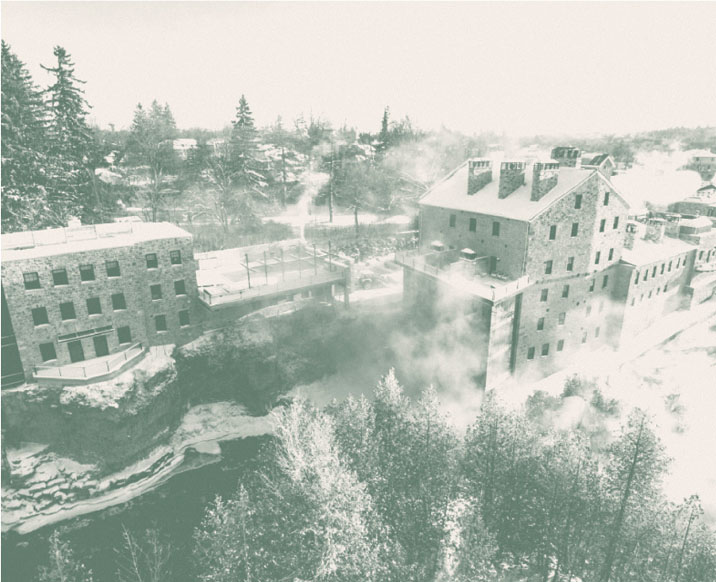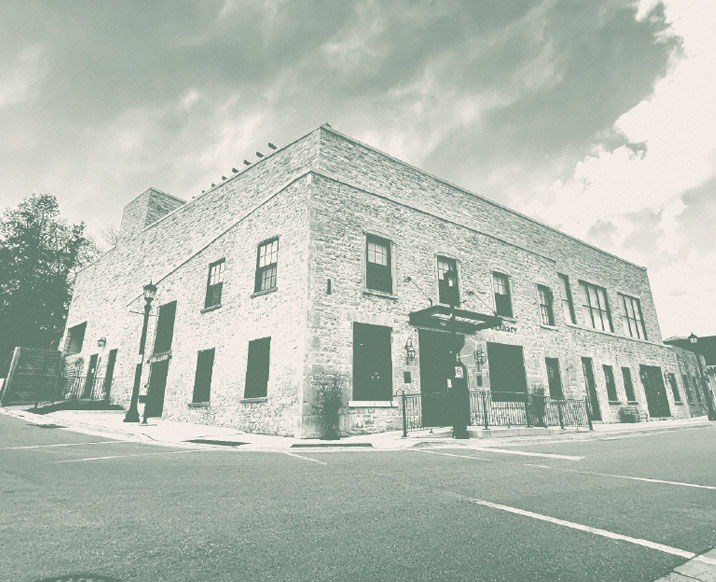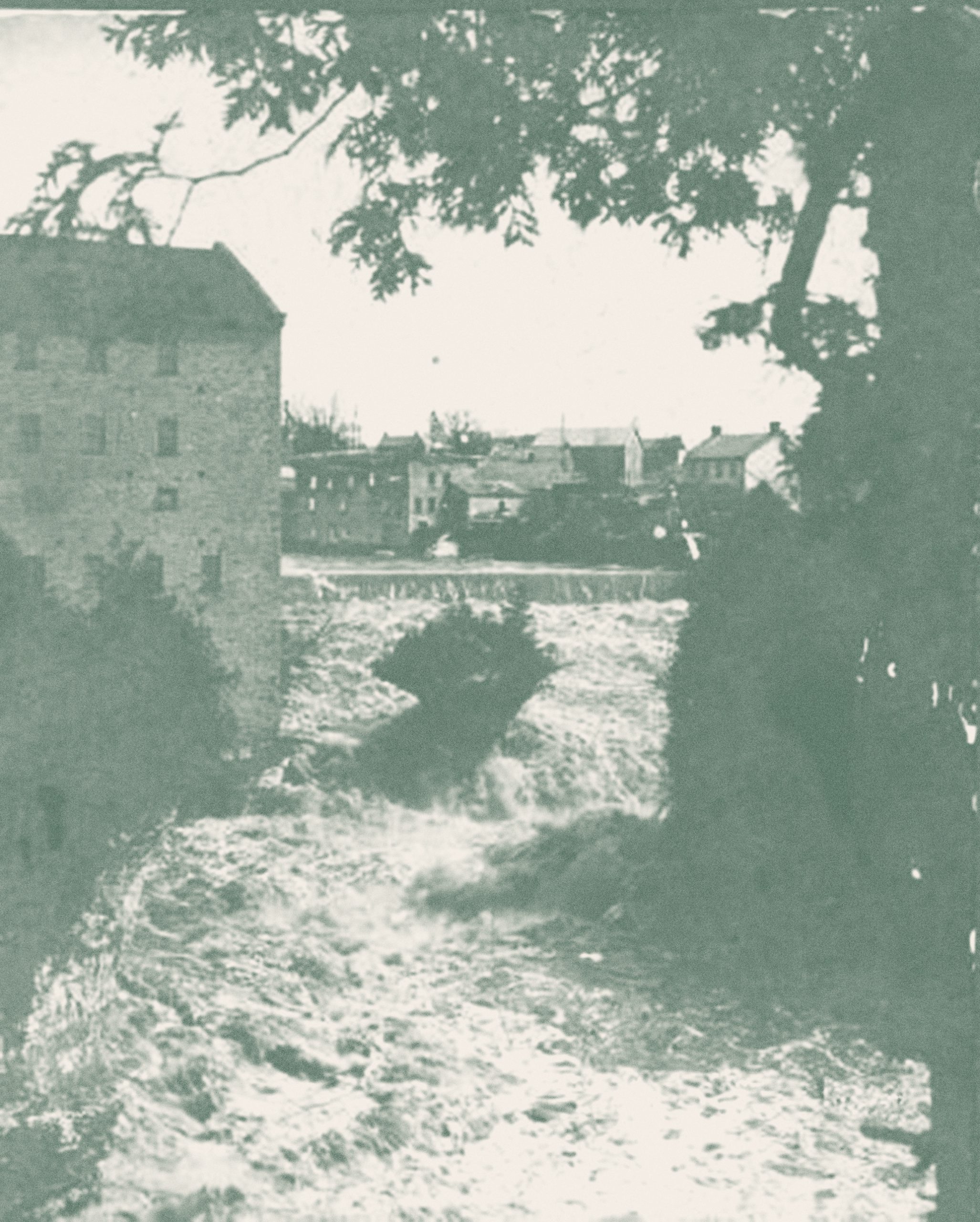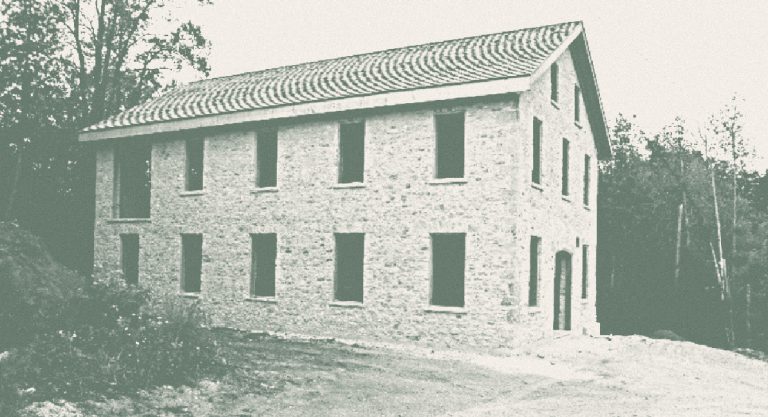Taking a tour of Elora Mill is like stepping into a picturesque dream. Nestled along the scenic Grand River in Ontario, Canada, this historic property offers a captivating blend of natural beauty and architectural charm. Learn more about our rich history below.
The Early History of the Elora Mill
The Elora Mill has a long and rich history that dates back all the way to 1833. William Gilkison, a Scottish Naval Captain was the person behind the original construction of the Mill. In 1832 Gilkison had a vision to build a Saw Mill that was to be located along the Grand River. In order to achieve this vision, Gilkison purchased land surrounding the river and laid out the original portion of the Village of Elora. Gilkison initially planned for the Saw Mill to be located on the south side of the river but ran into difficultly when trying to dynamite the thick limestone on the river’s edge. Due to this, the construction was moved to the north side of the Grand to the location that the Mill stands today.


The Elora Distillery
The Eastern part of the Elora Mill (where the kitchen is located) was once the Elora Mill Distillery. From 1859 to 1876 whiskey was brewed at the Distillery to be sold to local citizens and beyond. The business only lasted a short time however due to the questionable practices of the owner J.M Fraser and his views on alcohol taxation. The taxation of whiskey at the time was high and Fraser the owner of the Distillery was not willing pay – at least not for all of the alcohol that was being brewed. Because of this, the Distillery was on the top of the Chief Revenue Inspector Charles Romain’s “troublemakers list”. Throughout the years, Chief Romain made several efforts to catch the Distillery carrying out unlawful activities. The most notable of these efforts occurred in 1870 when the Chief conducted a surprise raid on the facility and arrived to find workers trying to drain a fermenting tank into a pipe that ran into the Grand River, to try to cover up just how much whiskey was being brewed. This incident prompted a shutdown of the Distillery for two weeks. After years of scandal and rumors the Elora Mill Distillery eventually closed in 1876.
The Granary
The Granary building has served a variety of different uses over the years. Dating back to 1855, the building was first constructed by William Knowles to serve as a cabinet workshop and retail space for a furniture business he was trying to establish. After nine years of operation, Knowles recognized that the furniture business was not taking off and decided to open a hardware store in the building. This shift in use proved to be a good decision for Knowles as the hardware store became so successful that the Granary building was expanded by a storey to accommodate demand. Knowles eventually gave up the store in Elora and moved the business to Downtown Toronto. Since Knowles’ ownership, the Granary has been used for a variety of different activities including a shipping department for the Mundell Factory and a lumber storage facility for Norman Drimmie.


The Tooth of Time
The Tooth of Time, one of Elora’s most well-known landmarks was almost destroyed in the early twenty century. On March 20th, 1903 the entire riverside wall of the Elora Mill collapsed into the river. Although the Mill was in poor condition at the time, the current owner George Fergusson was certain that the wall collapsed was due to the Tooth of Time was diverting high amounts of water onto the Mill’s foundation. Ferguson was determined to get the rock dynamited out of existence and had the majority of Elora citizen’s on board with his plan. The local newspaper at the time read “A grist mill in operation in the village is of far more importance than a lone rock in midstream — the one is a tax producer and a public convenience, the other simply a portion of rock indicating the height of land over which the Grand River tumbled in past ages.” The only factor that stopped the Tooth of Time from being destroyed was an extremely narrow vote by Village Council. Due to cost concerns, council decided that dynamiting the rock would not be in the best interest of town. It was this close and controversial council decision that sealed the fate of this local landmark.
The Grand River
It is not uncommon for unusual articles to show up in the trash rack at the Elora Mill Hydro Station. With this being said, the materials released into the Grand River today are nothing in comparison to the volume and types of materials that were released into the Grand River during 1870s through to the 1930s. During that time there was a strong local grain market in the town and a high demand for logs and saw. Due to this, large areas of forest along Grand River were completely cleared and stocked in piles for sale. When the river would flood, hundreds of logs, bark and trees would get pulled into the river. In addition to wood, several of the industries located near the river would release chemicals daily into the water stream. This included kettles of acid from Tanneries, dye vats from Woolen Mills and outhouse waste from business located along Mill Street. John Smith of the Elora Observer noted in 1873 that a visitor could smell the Grand long before he could see it. It wasn’t until the 1930s when the Grand River Valley Board of Trade was formed that the strong protection of the River began. Presently the Grand River Conservation Authority manages and protects the Grand River Watershed.

Themes of Elora
Delving into the rich history of Elora Mill over the last 100 years is a journey through time that reveals a captivating tapestry of transformation and tradition. From its humble beginnings as a flour mill in the early 20th century to its evolution into a luxurious resort and dining destination, the mill has witnessed a remarkable metamorphosis. Learning about its history unveils stories of resilience, community, and the preservation of heritage.
Feel free to peruse any section that piques your interest.
1 Settlement
First Nations
Indigenous people have been on these lands for over 13,000 years.
The Grand River and its tributaries served as transportation corridors, hunting grounds, growing food, and their camps.
Centre Wellington sits on the treaty lands and traditional territory of the Anishinaabe and the Haudenosaunee.
Elora
1832
Founded by William Gilkinson
Charles and Andrew Geddes laid out a town site on the west side of the river.
1833
Gilkinson opened a sawmill and general store just east of downtown Elora.
1850's - 1860's
The area was a major agricultural location with local stores selling local products.
A few small quarries existed in Elora over the years including one just north of the Davis St. bridge.
The Elora quarry was in production for about 18 years and was used in the building of many homes and buildings in the area.
https://www.wellingtonadvertiser.com/villages-quarry-created-by-elora-white-lime-co/
1858 - 1970
The arrival of the railway in 1870 changed the landscape of the area with some industries thriving due to access to goods and the ability to reach broader markets through shipping. This also changed the agricultural landscapes from subsistence farming to a commercial economy and resulted in changes to the agricultural built form such as farmhouses and barns.
Circa 1900 to 1952
Following the turn of the century, agriculture in the area shifted due to the introduction of steam engines, threshing cooperatives, and early gas or diesel engine tractors. Some of these were manufactured by local companies while others were brought by train. 1952 marks the incorporation of Fergus as a town.

1952 - 1999
The Township of Centre Wellington was formed in 1999 marking the end of the period of independent townships and towns.
2 Agriculture to Industry to Tourism
Step back in time to the 1820s and embark on a journey through the historical landscape of Centre Wellington, where the fertile soil has shaped the agricultural legacy of this township. From its early days to the present, agriculture has been an integral part of this community.
In the early and mid-nineteenth century, proximity to grist and flour mills was essential for farming families. Hamlets dotted the landscape, serving as vital hubs for daily necessities, social gatherings, and spiritual solace. These tight-knit communities often featured a church with a cemetery, a school, and a post office, each contributing to the distinctive character of the area. As the century progressed, schools became more prevalent in rural communities, enhancing the educational fabric of the region.
Agriculture in Centre Wellington was closely linked with the neighboring communities of Elora and Fergus. The strategic use of railways, storage warehouses, and cattle markets transformed the agricultural landscape. It was a time when pioneers carefully selected their lots, avoiding wetlands in favor of rolling terrains.
Early farmers began by clearing land, giving rise to a crop-centric existence. Over time, improved crop production facilitated the expansion of the transportation network, enabling farmers to transport their products to broader markets. Livestock quality also witnessed significant improvements, with wheat, peas, barley, and oats dominating the landscape in 1852. As wheat became a major export crop, mixed farming and livestock gained prominence, resulting in the construction of innovative wheat barns and stone stables.
The typical Ontario farmstead layout was influenced by numerous factors. Log cabins provided early shelter, set back for privacy, while later stone or brick farmhouses were built closer to the road, acting as showpieces. A deliberate separation of buildings served the dual purpose of fire safety and allowing sufficient space for maneuvering horse-drawn wagons. Barns were strategically nestled into slopes to ensure drainage, provide panoramic views, and offer dual-level entry points. Rows of trees lined driveways, providing windbreaks and enhancing the aesthetics of these farmsteads.
The late nineteenth century witnessed a shift towards mechanization, leading to larger field sizes. The advent of electricity and tractors in the early twentieth century further revolutionized agriculture, enhancing efficiency and crop production. Tower silos became a familiar sight around 1900, used for storing crops. Today, many barns stand empty as crops are rapidly transported for processing.
With the rise of automobiles and trucks in the early twentieth century, farmers expanded their horizons, reducing reliance on small neighborhood communities for supplies and community interactions. Centre Wellington’s agricultural heritage tells a captivating story of growth, innovation, and adaptation.
(Source: Cultural Heritage Landscape Study & Inventory of the Township of Centre Wellington – Volume 1, Prepared for the Township of Centre Wellington, June 2021, Pages 24-25)
3 Key People Throughout Elora's History
Discover the Legacy of William Gilkison: Founder of Elora
William Gilkison’s life is a tale of adventure, entrepreneurship, and the foundation of a vibrant community. Born on March 7, 1777, in Irvine, Ayrshire, Scotland, he left an indelible mark on the history of Elora, Ontario.
A Multifaceted Journey: William Gilkison was more than just a settler; he was a sailor, an explorer, a land speculator, and the visionary founder of Elora. His journey took him from the Napoleonic wars to the War of 1812, where he valiantly fought in battles such as the Battle of Crysler’s Farm.
Emigration & Return
In 1796, he embarked on a new adventure by emigrating to North America. After marrying Isabella Grant, he returned briefly to Scotland before returning in 1832, this time alongside John Galt, the notable superintendent of the Canada Company and founder of Guelph.
Family & Home
In 1803, William married Isabella Grant, and together, they raised six children. Sadly, in 1826, he lost his beloved wife. His connection with John Galt was not just professional; they were related, adding another layer to the history of this remarkable figure.
Founding Elora
In 1832, William Gilkison founded Elora, originally known as the Irvine Settlement. He acquired approximately 14,000 acres of land in Nichol Township, near the picturesque falls of the Grand River. His residence, a testament to history, still stands proudly at 71 Gilkinson Circle, Elora, along the scenic banks of the Grand River.
Entrepreneurship
Gilkison’s enterprising spirit led him to build and operate a sawmill and a general store, commencing in 1832. The sawmill was strategically located on the north side of the river, near what we now know as the Elora Mill. This choice offered convenience and accessibility, paving the way for the community’s growth.
Legacy Unveiled
The town’s layout was expertly designed by Lewis Burwell, the deputy provincial land surveyor, in late 1832. The village earned its name, Elora, when the post office was established in 1839. This name was a tribute to his brother’s ship, the “Ellora Caves,” which sailed in the waters of India.
Incorporation and Beyond
Elora was officially incorporated in 1858, a status it maintained until 2001 when it was amalgamated with Fergus, forming the Township of Centre Wellington.
William Gilkison’s story is intertwined with the rich history of Elora, a testament to a pioneer who shaped this vibrant community. Explore more about this remarkable figure through various sources, including Heritage Trust and Carilynn27’s Blog.
Explore the Enigmatic Legacy of J.M. Fraser: The Elora Mill's Dynamic Operator
Step into the intriguing world of J.M. Fraser, a character who left a distinct mark on the Elora Mill in 1846. Fraser was more than just a mill operator; his story is steeped in history and enigma.
A Man of Action
J.M. Fraser took over the Elora Mill, transforming it into a hub of activity that included a flour mill and distillery. His entrepreneurial spirit was undeniable, and his vision shaped the mill’s legacy.
Fiery Personality: Hailing from Scotland, Fraser was renowned for his fiery personality and an explosive temper. His vibrant character made him a notable figure in the community, leaving an indelible impression on those who crossed his path.
The Elora Bantam
Fraser earned a unique nickname during his time – “The Elora Bantam.” This moniker captured his self-assured, self-important demeanor and the way he carried himself. He strutted about with undeniable confidence, making his presence felt wherever he went.
Unveiling the Past
Delve deeper into the life and times of J.M. Fraser and his association with the Elora Mill through insightful sources like Wellington Advertiser. His story is a captivating chapter in the history of the Elora Mill, reflecting the dynamism and character of this remarkable figure.
4 Natural Environment & Geography
Discover the Rich Heritage of Centre Wellington
Grand River
A Canadian Heritage River The Grand River and its tributaries, including the Conestoga, Eramosa, Nith, and Speed rivers, were honored with the prestigious designation of Canadian Heritage Rivers in 1994. This recognition is a testament to the outstanding human heritage values and exceptional recreational opportunities that abound along the riverbanks. With a history that spans over 10,000 years of Indigenous presence and further enriched by the settlers in the 18th and 19th centuries, the Grand River is home to numerous dams, mills, bridges, historic homes, and archaeological sites. It offers a wide array of recreational activities, from boating, fishing, and hiking to camping, skiing, wildlife viewing, and exploration of historical sites. Learn more
Elora
A Name Inspired by India’s Ellora Caves Elora, with its unique and captivating name, finds its roots in the Ellora Caves of India. Explore the mysterious temples and rock-cut architecture that inspired the nomenclature of this charming town. Read more
Elora's Limestone Legacy
Elora’s architectural charm is closely tied to its abundant limestone resources. This history of construction with limestone has left an indelible mark on the town’s character. The use of locally quarried limestone in the construction of historic homes, churches, bridges, and commercial buildings has created a unique architectural landscape that has stood the test of time. The quarries in the Elora Gorge supplied the demand for this durable and distinctive building material, and the building boom in Toronto in the early 20th century boosted the quarrying industry. The evolution of architectural styles, from Victorian to Gothic Revival and Georgian, has resulted in a diverse range of buildings that showcase Elora’s evolving built environment. Today, Elora’s limestone-built heritage remains a significant draw for tourists and history enthusiasts. Efforts to preserve and restore these historic limestone structures are ongoing, ensuring that Elora’s heritage endures for future generations. Learn more
The Tooth of Time
A Historic Icon On March 20, 1903, a dramatic event unfolded as the Elora Mill’s riverside wall collapsed into the river, endangering the iconic Tooth of Time. This incident was a result of the mill’s reconstruction after a fire in 1870, which had weakened the riverside wall. Thankfully, no injuries occurred during this incident. In the town’s early days, some debated the removal of the islet rock, believing it diverted water against the Elora Mill wall. Elora Council, however, decided against paying for its removal, and the islet rock remained, preserving the iconic Tooth of Time. Discover the full story
Immerse yourself in the rich cultural and historical tapestry of Centre Wellington, where the Grand River, captivating caves, limestone architecture, and iconic landmarks await your exploration.
5 Artist
Unveiling Elora's Artistic Heritage
The roots of Elora’s artistic soul run deep, tracing back to its early 19th-century settlement. Nestled in a region of unparalleled natural beauty, Elora has always been a magnet for artists captivated by its scenic landscapes and unique charm. These visionaries, often inspired by the breathtaking vistas, historic architecture, and the very essence of the land, beautifully immortalized Elora’s allure in their works.
As time flowed, so did the artistic spirit, and Elora blossomed into a nurturing haven for creative minds. Local artists and artisans naturally gravitated towards one another, forming networks, sharing techniques, and engaging in collaborative projects. This spirit of community nurtured a fertile ground for artistic growth, contributing to the evolution of various creative expressions.
Meet AJ Casson: A Pinnacle of Artistry
Among the luminaries of Elora’s artistic tapestry, one figure stands tall—AJ Casson. His work and influence have left an indelible mark on the local art scene, embodying the essence of Elora’s artistic heritage.
Celebrating Art in All Its Forms
Elora’s unwavering commitment to its artistic culture shines through a calendar brimming with cultural events and festivals. These celebrations encompass a diverse range of art forms, from visual arts to music, theater, and literature. Notable events that grace Elora’s cultural calendar include the Elora Festival, Monster Month, Riverfest, and the Elora Fergus Studio Tour.
The Elora Centre for the Arts: A Hub of Creativity
At the heart of Elora’s artistic aspirations lies the Elora Centre for the Arts. This creative hub, nestled within a historic building, serves as a central point for a multitude of artistic endeavors. It not only provides a stage for local and visiting artists to showcase their creations but also fosters engagement with the community, breathing life into Elora’s vibrant arts scene.
Embrace Elora’s artistic heritage, where creativity flows like the Grand River, and the landscape serves as a canvas for inspiration. Explore the world of art in a town that celebrates imagination, innovation, and the boundless possibilities of creative expression.
Source: Centre for the Arts Website
6 Waterpower and Milling
A Glimpse into Elora's 19th-Century Industrial Landscape
In 1846, Elora was a bustling town, home to approximately 100 residents. This vibrant community boasted two churches, three flourishing mills, a bustling post office, and a welcoming tavern.
The Power of Flowing Waters: A Catalyst for Industry
The relentless flow of the Grand River and Irvine River, along with the numerous creeks crisscrossing the townships, played a pivotal role in driving industrial development during the mid-19th century. Dams were strategically erected in key locations like Elora, Fergus, Aboyne, and Belwood. These structures facilitated the harnessing of waterpower, sparking an era of industrial growth. Both Fergus and Elora were dotted with sawmills, grist mills, and woolen mills, with Drimmie’s Mill (later known as Elora Mill) and Wilson’s Mill (also known as Monkland Mills) becoming well-known landmarks. Meanwhile, Salem thrived with water-powered industries, including Wissler’s Mill and Erb’s Mill, along the Irvine River, while Aboyne housed several mills.
The Perseverance of Industry: Rebuilding from Flames
Mills were at the heart of this burgeoning industrial landscape, but they were not without their challenges. Fires frequently ravaged these vital structures, necessitating multiple reconstructions throughout the townships. Moreover, the latter half of the 19th century witnessed many industries transitioning to auxiliary steam power, as the limitations of river-based factories became apparent due to unreliable water flow, flooding, and other constraints.
Electrifying Progress: The Advent of Electricity
The early 1890s brought a significant turning point with the arrival of electrical power. This innovative development improved working conditions, enabling night shifts and enhancing operations like weaving and sewing. Dr. Abraham Groves of Fergus made pioneering use of steam power to generate electricity in the region, a quarter-century before hydro-electricity reached these parts.
Explore the remarkable industrial heritage of Elora and the surrounding townships, where the relentless flow of waters and the spirit of innovation shaped a dynamic landscape of industry and progress.
Source: [Cultural Heritage Landscape Study & Inventory of the Township of Centre Wellington – Volume 2 Appendices A – J](https://www.centrewellington.ca/Modules/News/index.aspx?feedId=4d465a9b-071e-430c-a1d7-9f5ea5310524, 25)
7 Elora Mill Historic Building Restoration
Restoring History: Elora Mill and the Walser Building
In the heart of Elora, a remarkable transformation is underway, breathing new life into two iconic landmarks—Elora Mill and the Walser Building. These restoration efforts are more than just construction; they are a journey back in time and a celebration of heritage and architectural splendor.
Elora Mill: A Historic Gem Reborn
The Elora Mill, with its rich history dating back to the 19th century, has always been a symbol of elegance and refinement. Now, with painstaking restoration, this historic gem is being meticulously brought back to its former glory. Every brick, beam, and intricate detail is a testament to the dedication of preserving the past. The restoration of the Elora Mill is not just a renovation; it’s a resurrection of a bygone era, where elegance met modernity. Every effort is being made to honor the original design while seamlessly incorporating contemporary comforts. The result is a space where history and luxury coexist, offering an unparalleled experience to all who step through its doors.
The Walser Building: A Bridge to the Past
The Walser Building, standing proudly in Elora’s historic core, is a bridge to the past. Its restoration efforts echo the town’s commitment to preserving its architectural heritage. The Walser Building is not just a structure; it’s a living testament to Elora’s cultural identity and evolving charm.
The restoration of the Walser Building is a labor of love, where each brick and architectural element is meticulously revitalized. The building’s rejuvenation is a journey through time, celebrating the town’s heritage while making room for contemporary businesses and experiences. This harmonious blend of old and new reflects the essence of Elora itself—a town that respects its history while embracing the future.
A Commitment to Preservation
The restoration of Elora Mill and the Walser Building represents the collective commitment of the community to preserve its heritage and architectural treasures. These efforts not only restore physical structures but also rejuvenate the spirit of the town. They allow residents and visitors to immerse themselves in the past while enjoying the comforts of the present.
As these restoration projects unfold, Elora continues to pay homage to its roots, celebrating its rich history, architectural beauty, and the enduring legacy of its historic buildings.
Come and witness the journey of preservation and transformation in Elora. Explore the stories, craftsmanship, and enduring charm of Elora Mill and the Walser Building, where history and modernity intertwine, creating a truly unique experience
Explore the remarkable industrial heritage of Elora and the surrounding townships, where the relentless flow of waters and the spirit of innovation shaped a dynamic landscape of industry and progress.

